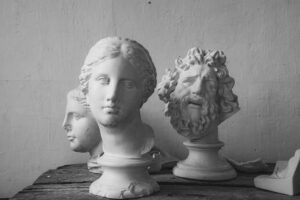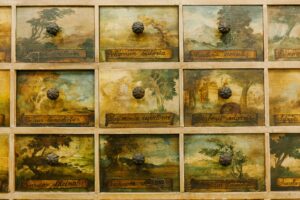Welcome to the enchanting world of sculpture! If you’re a lover of art, then you know that there’s something special about three-dimensional art forms. Sculpture is one such form that has captivated humanity for centuries, with its ability to breathe life into stone, metal or other materials. Through this blog post, we’ll dive into the mesmerizing realm of sculpture and learn about its history, techniques and various styles. So buckle up for an amazing journey as we explore the fascinating world of three-dimensional art!
What is Sculpture?
Sculpture is a three-dimensional art form that has existed since the dawn of civilization. Sculpture can be created from a variety of materials, including stone, metal, wood, glass, and clay. The medium often dictates the final form of the sculpture; for example, a stone sculpture will have a very different appearance from a wooden one.
Sculpture is often used to depict human figures or other objects in a lifelike manner. However, it can also be abstract, as in the case of many modern sculptures. In general, the goal of sculpture is to create an aesthetically pleasing object that can be viewed from all angles.
While some sculptures are intended to be viewed only from one angle, others are designed to be interactive and require viewer participation. For example, many public sculptures invite viewers to touch or climb on them. This type of sculpture is often called “environmental” or “site-specific.”
Sculpture can serve a variety of purposes, both practical and aesthetic. Many sculptures are created simply for their beauty, while others are meant to convey a particular message or tell a story. Some sculptures are even made for functional purposes such as providing shade or serving as a fountain.
A Brief History of Sculpture
Sculpture is an art form that dates back thousands of years. The earliest known sculptures are from the Mesolithic period, which began around 10,000 BCE. These early sculptures were mostly small figurines made of bone or stone.
The first major period in the history of sculpture was the Neolithic period, which began around 7000 BCE. This was a time when people first began to use clay to make sculpture. The most famous examples of Neolithic sculpture come from the island of Malta, where the temples at Ħaġar Qim and Mnajdra are decorated with numerous clay statues.
The Bronze Age was another major period in the history of sculpture. This began around 3000 BCE and lasted until 1200 BCE. During this time, bronze became the main material used for making sculpture. Some of the most famous Bronze Age sculptures include the “Venus” of Willendorf and the “Dying Gaul”.
The Iron Age was the final major period in the history of sculpture. This began around 1200 BCE and lasted until 550 BCE. During this time, iron became the main material used for making sculpture. One of the most famous examples of Iron Age sculpture is the “Charioteer of Delphi”.
The Different Types of Sculpture
There are many different types of sculpture, each with its own unique characteristics. Here are some of the most common types:
-Abstract sculpture is characterized by its lack of representational form. This type of sculpture often uses geometric shapes and forms to create a sense of balance and harmony.
– figurative sculpture represents the human figure or other living forms. This type of sculpture can be realistic or idealized, and often conveys emotion through the use of movement and gesture.
– kinetic sculpture is designed to move, either by means of an external power source or through the use of internal mechanisms. These sculptures often incorporate elements of light and sound, making them interactive and engaging.
– environmental sculpture is designed to interact with its surroundings, whether that means responding to the environment in a functional way or simply complementing the natural landscape.
Tools of the Trade
As with any art form, there are certain tools that are essential to creating a sculpture. These tools can be as simple as clay and a potter’s wheel, or as complex as a laser cutter and 3D printer.
No matter what your medium, there are a few basic tools that you’ll need to get started:
-A work surface: This can be anything from a tabletop to a dedicated workspace in your garage or basement. Just make sure it’s clean and flat so you can work easily.
-Clay: One of the most versatile materials for sculpture, clay can be molded by hand or worked on a potter’s wheel. It can be fired in a kiln to create permanent sculptures, or left unglazed for more temporary works.
-Wood: Another popular material for sculpture, wood can be carved, chiseled, or sanded into shape. It can also be burned or stained for different effects.
-Metal: Metal is another versatile material that can be hammered, welded, or cast into shape. It can also be polished or patinated for different effects.
-Stone: Stone is one of the oldest materials used for sculpture, and can be carved, drilled, or polished into shape. It is also very durable, making it ideal for outdoor sculptures.
The Sculpting Process

When it comes to creating a sculpture, there is no one-size-fits-all approach. The process of sculpting can vary depending on the materials used, the subject matter, and the artist’s own style and preferences. However, there are some general steps that most sculptors follow when creating a new piece.
The first step is to come up with an idea for the sculpture. This can be inspired by anything from real-life objects to other works of art. Once the artist has an idea in mind, they will start to sketch out their concept. This helps them to visualize the final piece and plan out the details of the sculpture.
Next, the artist will begin to assemble the materials they will need for their sculpture. This can include anything from clay and wood to metal and stone. Once all of the materials are gathered, the artist will begin to work on shaping them into their desired form. This is where their creative vision really comes into play, as they manipulate the materials into something that represents their initial idea.
The last step in the sculpting process is finishing touches. This can involve adding paint or other decorations to the sculpture, or simply polishing it until it achieves its desired look. No matter what approach an artist takes, crafting a sculpture is a complex and rewarding process that results in a beautiful work of art.
Famous Sculptures
There are many famous sculptures that have been created throughout history. Some of the most famous sculptures include the Venus de Milo, the Parthenon Marbles, and Michelangelo’s David. These sculptures are renowned for their beauty and craftsmanship, and they continue to be popular tourist attractions today.
In Greece, the Venus de Milo is one of the most famous sculptures in existence. It dates back to around 150 BCE and was discovered on the island of Milos. The sculpture is believed to depict the goddess Aphrodite, and it is considered to be one of the greatest examples of Classical Greek art.
The Parthenon Marbles are a collection of sculpted stone blocks that were originally part of the Parthenon temple in Athens. They were created between 447 and438 BCE by the Greek sculptor Phidias. The marbles were later removed from the Parthenon by Lord Elgin in the early 1800s and taken to Britain, where they remain on display at the British Museum.
Michelangelo’s David is one of the most famous statues in the world. It was created between 1501 and 1504 out of a block of Carrara marble, and it currently resides at the Accademia Gallery in Florence, Italy. The statue depicts the Biblical hero David preparing to fight Goliath, and it is widely considered to be one of Michelangelo’s greatest masterpieces.
Conclusion
Sculpture is an art form that has been around for centuries and remains as popular today as ever. It provides us with a unique way of exploring our physical and emotional worlds, allowing us to express ourselves creatively. Whether you are just getting into sculpture or have been practicing it for years, there are countless materials, techniques, and styles available to experiment with. Hopefully this article has given you the basic knowledge about sculpture so that you can start your journey into the world of three-dimensional art!








